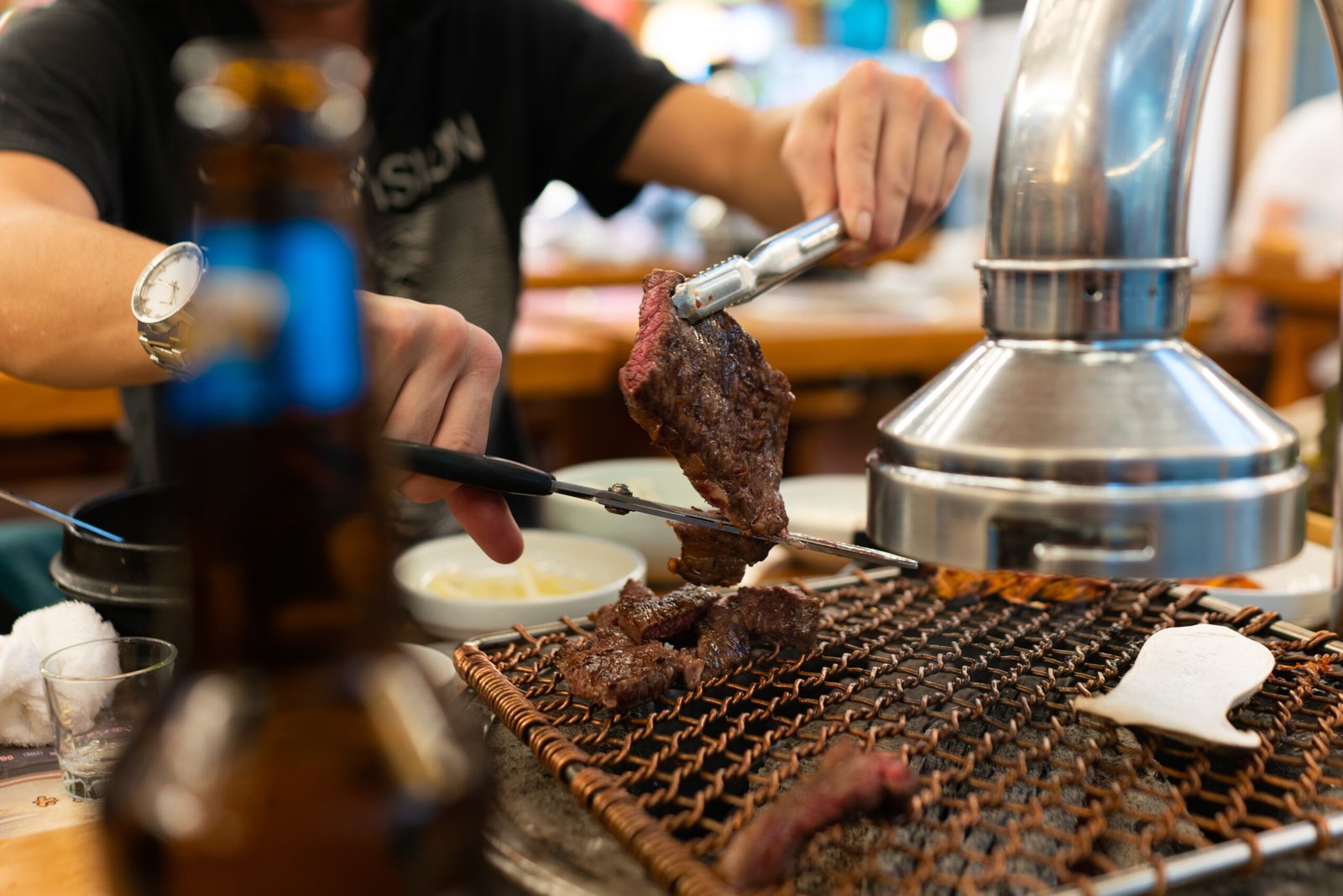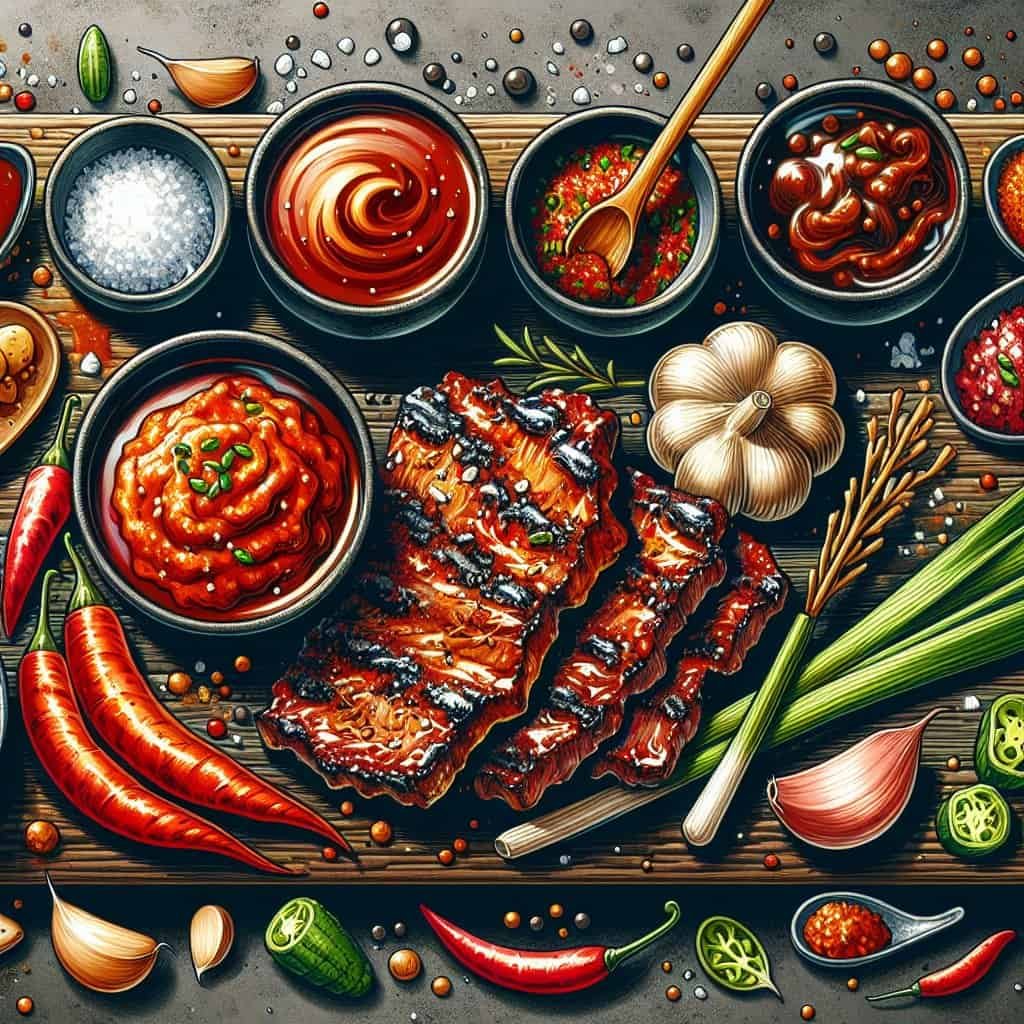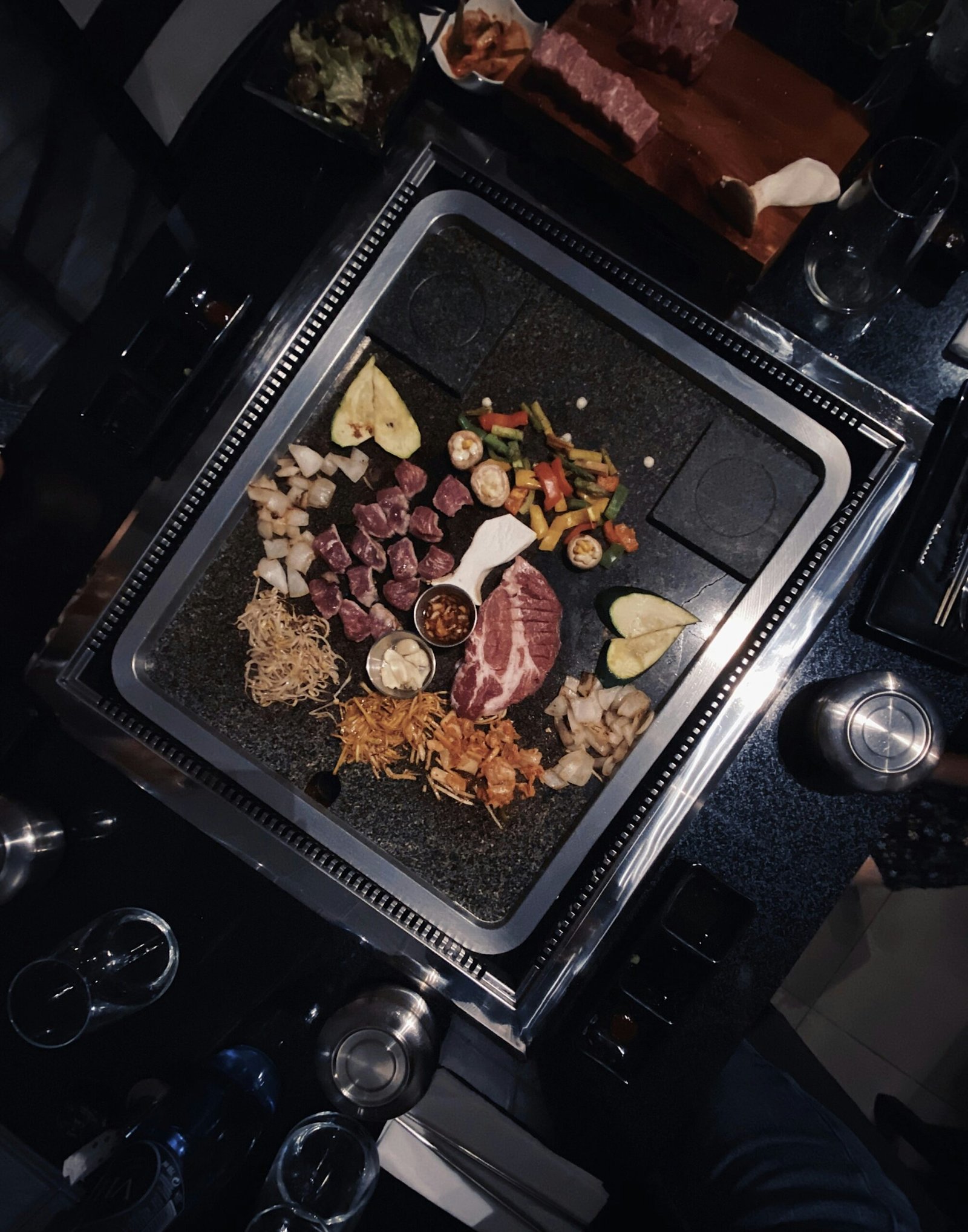If you’re a fan of Korean cuisine or barbecue, you’ll be delighted to learn about the latest trends in using Korean flavors in barbecue sauces and glazes. From the vibrant and spicy gochujang to the tangy and savory soy-based marinades, Korean flavors are making their way into the realm of barbecue, adding a mouthwatering twist to traditional grilled dishes. Whether you’re grilling up juicy ribs or marinating succulent chicken wings, these innovative Korean-inspired sauces and glazes are sure to elevate your next barbecue experience to a whole new level of deliciousness. Get ready to tantalize your taste buds as we explore the exciting world of Korean flavors in barbecue sauces and glazes.

Background of Korean Flavors in Barbecue Sauces and Glazes
Introduction to Korean cuisine
Korean cuisine is known for its bold and complex flavors, and one of the most popular ways these flavors are showcased is through barbecue sauces and glazes. Korean barbecue, or “gogi-gui,” is a traditional method of grilling meat, typically beef, pork, or chicken, at the table. The use of various sauces and glazes adds depth and complexity to the grilled meats, resulting in a mouthwatering and unforgettable dining experience.
Historical significance of Korean flavors in barbecue sauces
The history of Korean barbecue sauces and glazes dates back centuries, with influences from both indigenous ingredients and foreign cultures. Traditional Korean barbecue sauces were initially developed using local ingredients such as soybean paste, chili paste, sesame oil, garlic, and ginger. These flavors were incorporated not only for their taste but also for their medicinal and health benefits. Over time, Korean cuisine and barbecue sauces have been influenced by neighboring countries like Japan and China, leading to the evolution of unique flavor profiles.
Evolution of Korean barbecue sauces and glazes
In recent years, Korean cuisine has gained immense popularity worldwide, leading to a surge in demand for Korean flavors in various culinary applications. This trend has also influenced the development of Korean barbecue sauces and glazes, with chefs and food enthusiasts exploring innovative ingredients and fusion flavors. The evolution of Korean barbecue sauces has opened up new possibilities, allowing for the creation of unique flavor combinations and experiences that appeal to a global audience.
Traditional Korean Flavors Used in Barbecue Sauces and Glazes
Gochujang: The staple Korean chili paste
Gochujang is a staple ingredient in Korean cuisine, particularly in barbecue sauces and glazes. This fermented chili paste adds a spicy and slightly sweet flavor to the sauces, creating a perfect balance of heat and depth. The unique umami taste of gochujang comes from its traditional fermentation process, which involves the use of glutinous rice, fermented soybeans, and chili powder. The complexity and richness of gochujang make it an essential component in traditional and modern Korean barbecue sauces.
Doenjang: Traditional fermented soybean paste
Another key ingredient in Korean barbecue sauces is doenjang, a traditional fermented soybean paste. Doenjang adds a savory and slightly salty note to the sauces, enhancing the overall umami flavor profile. This paste is made by fermenting soybeans with salt and often includes other ingredients like barley, wheat, or rice. The fermentation process gives doenjang its distinct flavor and contributes to the deep and rich taste of Korean barbecue sauces.
Sesame oil: Enhancing nutty flavors
Sesame oil is commonly used in Korean cuisine and plays a vital role in enhancing the nutty flavors in barbecue sauces and glazes. The toasty and aromatic characteristics of sesame oil add depth and complexity to the sauces, elevating the overall taste profile. It is crucial to use high-quality toasted sesame oil to achieve the desired flavors. The addition of sesame oil not only enhances the taste but also imparts a delightful aroma to the barbecue sauces.
Garlic and ginger: Aromatic additions
Garlic and ginger are aromatic ingredients that are widely used in Korean cuisine and have a significant presence in barbecue sauces and glazes. These ingredients add an intense and fragrant taste to the sauces, providing a burst of flavor with every bite. The pungent and spicy notes of garlic and the zesty and warming characteristics of ginger complement the other flavors in the sauces, creating a harmonious balance. The combination of garlic and ginger gives Korean barbecue sauces their distinct aroma and adds dimension to the overall taste.

Incorporating Fusion Flavors in Korean Barbecue Sauces
Kimchi-infused barbecue sauces and glazes
Kimchi, a traditional Korean side dish made from fermented vegetables, has gained popularity around the world due to its unique flavor and health benefits. This iconic ingredient has found its way into Korean barbecue sauces, adding a tangy, spicy, and slightly sour taste. The addition of kimchi not only enhances the flavor profile but also provides a memorable and distinct experience for barbecue enthusiasts. The combination of smoky grilled meats and kimchi-infused barbecue sauce creates a delightful fusion of flavors.
Soy sauce and mirin: Japanese influence
Japanese cuisine has had a significant influence on Korean culinary traditions, and this is evident in the use of soy sauce and mirin in Korean barbecue sauces. Soy sauce adds a savory and slightly sweet taste to the sauces, while mirin, a sweet rice wine, imparts a delicate sweetness and depth of flavor. The combination of these two ingredients creates a harmonious blend of umami flavors, incorporating the best of both Korean and Japanese culinary traditions.
Wasabi and gochujang amalgamation
For those who enjoy a bit of heat in their barbecue sauces, the amalgamation of wasabi and gochujang is a perfect choice. Wasabi, a staple in Japanese cuisine, adds a distinctive and fiery flavor to the sauces. When combined with the spiciness of gochujang, it creates a unique and tantalizing taste experience. This fusion of flavors is not only delicious but also showcases the seamless blending of Korean and Japanese culinary influences.
Thai chili and Korean barbecue fusion
In recent years, the fusion of Korean and Thai flavors has become increasingly popular. Thai chili, known for its vibrant spiciness and citrusy undertones, adds a refreshing twist to Korean barbecue sauces. The combination of Thai chili and Korean barbecue creates a harmony of flavors, providing a delightful burst of heat and tanginess. This fusion option appeals to those who seek a balance between intense spiciness and bright, citrusy flavors.
Innovative Ingredients in Modern Korean Barbecue Sauces
Asian pear: Natural sweetener and tenderizer
Asian pear, often referred to as Korean pear, is a popular ingredient in modern Korean barbecue sauces. Its naturally sweet and juicy characteristics provide a delightful balance to the spiciness and savory flavors present in the sauces. Additionally, the enzymes present in Asian pear act as a natural meat tenderizer, ensuring that the grilled meats remain juicy and tender. The use of Asian pear in barbecue sauces enhances not only the taste but also the texture and overall dining experience.
Pomegranate: A tangy twist
Pomegranate, with its tangy and slightly sweet taste, has become a sought-after ingredient in modern Korean barbecue sauces. The vibrant red color and refreshing flavor of pomegranate juice add a unique twist to the sauces, creating an exciting and memorable dining experience. Pomegranate’s tartness complements the richness of the grilled meats and provides a delightful contrast of flavors.
Chili threads and flakes: Adding texture and heat
To add texture and an extra kick of heat to Korean barbecue sauces, chili threads and flakes are commonly used. These small, fiery red threads and flakes provide a visual appeal to the sauces, while also boosting the spiciness and adding a slight crunch to each bite. The inclusion of chili threads and flakes not only enhances the overall flavor profile but also creates a visually stunning presentation.
Peanut butter: Creaminess and depth of flavor
Peanut butter may seem like an unexpected addition to Korean barbecue sauces, but its creamy texture and nutty flavor add richness and depth to the sauces. The combination of savory and sweet flavors creates a tantalizing taste experience, while the smooth consistency of peanut butter lends a silky mouthfeel. This innovative ingredient adds a unique twist to traditional Korean barbecue sauces, appealing to those who appreciate a combination of bold and comforting flavors.

Health Conscious Korean Barbecue Sauces
Reduced sodium and sugar options
As health-conscious eating becomes increasingly popular, the demand for reduced sodium and sugar options in barbecue sauces has grown. Korean barbecue sauce brands have responded to this trend by offering reduced sodium and sugar versions of their sauces. These healthier options allow individuals to enjoy the bold and flavorful taste of Korean barbecue sauces while minimizing their intake of sodium and sugar.
Gluten-free and vegan alternatives
Another significant trend in the culinary world is the increasing demand for gluten-free and vegan options. Korean barbecue sauce brands have taken note of this and now offer gluten-free options, ensuring that individuals with dietary restrictions can still enjoy the rich flavors of Korean barbecue. Additionally, many brands have developed vegan alternatives that do not compromise on taste, making Korean barbecue accessible to a wider audience.
Organic and all-natural ingredients
The shift towards organic and all-natural ingredients has not gone unnoticed by Korean barbecue sauce brands. Many brands are now offering sauces made with organic and all-natural ingredients, appealing to individuals who prioritize clean eating and sustainable sourcing. These sauces prioritize the use of high-quality ingredients, allowing consumers to enjoy the flavors of Korean barbecue while knowing that they are making a conscious choice.
Low-calorie and fat-free choices
For those watching their calorie and fat intake, Korean barbecue sauce brands have developed low-calorie and fat-free options. These sauces offer a lighter alternative without compromising on taste. By reducing the calorie and fat content, individuals can enjoy the flavors of Korean barbecue guilt-free, making it a more inclusive dining experience for individuals with specific dietary needs.
Crafting Unique Korean Barbecue Sauce Combinations
Incorporating fruit juices and extracts
To create unique flavor profiles, chefs and home cooks alike are incorporating fruit juices and extracts into Korean barbecue sauces. Juices such as orange, pineapple, and apple add a touch of sweetness and acidity to the sauces, creating a fruity twist. Extracts like lemon or lime zest bring a burst of freshness and citrus aroma. These additions create dynamic and memorable taste combinations, elevating the traditional Korean barbecue experience.
Experimenting with different types of vinegar
Vinegar is an essential component in many barbecue sauces, as it adds acidity and tanginess. To create unique Korean barbecue sauce combinations, chefs and enthusiasts are experimenting with different types of vinegar. Traditional Korean rice vinegar, apple cider vinegar, and balsamic vinegar offer distinct flavor profiles that can enhance the taste of the sauces. This experimentation allows for endless possibilities, resulting in exciting variations of Korean barbecue sauces.
Spices and herbs for additional complexity
To add complexity and depth to Korean barbecue sauces, spices and herbs are being incorporated into the recipes. Ingredients like black pepper, paprika, cumin, and thyme add earthy and aromatic notes, enhancing the overall flavor profile. These additions bring a new dimension to Korean barbecue sauces, allowing for a personalized touch and the opportunity to explore unique taste combinations.
Inclusion of fermented ingredients
The use of fermented ingredients has a long-standing tradition in Korean cuisine, and this trend has extended to Korean barbecue sauces. Chefs and food enthusiasts are experimenting with the inclusion of fermented ingredients like fermented black beans, fermented shrimp paste, and fermented vegetables in their barbecue sauces. These ingredients not only add complexity and richness to the sauces but also provide probiotic benefits, promoting gut health and overall well-being.

Regional Variations of Korean Barbecue Sauces
Seoul style: Gochujang and soy-based
Seoul, the capital city of South Korea, has its own regional variation of Korean barbecue sauce. The Seoul-style barbecue sauce typically features a gochujang and soy sauce base. This combination creates a harmonious blend of spicy, sweet, and savory flavors, highlighting the bold taste profile that Korean cuisine is known for.
Jeju Island sauce: Citrusy and seafood-infused
Jeju Island, located off the southern coast of South Korea, is known for its fresh seafood and unique culinary traditions. The Jeju Island barbecue sauce pays homage to these culinary traditions, incorporating citrusy flavors and seafood elements. The sauce often includes ingredients like citrus fruits, oysters, and seafood stock, creating a bright and refreshing taste that complements the grilled meats perfectly.
Busan barbecue glaze: Spicy gochujang mixed with local seafood
Busan, a port city in South Korea, has its own regional variation of barbecue sauce. The Busan barbecue glaze combines the spiciness of gochujang with the abundance of local seafood. The sauce features ingredients like chili paste, chili flakes, fermented seafood, and seafood stock, resulting in a fiery and richly flavored glaze that pairs beautifully with grilled seafood.
Gwangju-inspired sauce: Using local agricultural produce
Gwangju, a city located in the southwestern region of South Korea, has a rich agricultural heritage. The Gwangju-inspired barbecue sauce showcases the flavors of the local produce, incorporating ingredients like chestnut, persimmon, and barley. This sauce offers earthy and slightly sweet notes that complement the grilled meats and create a distinctly Gwangju taste experience.
Popular Korean Barbecue Sauce Brands
Bulgogi Brothers
Bulgogi Brothers, a well-known Korean barbecue restaurant chain, has gained popularity for its high-quality barbecue sauces. Their sauces are crafted using traditional Korean flavors, ensuring an authentic taste experience. Bulgogi Brothers offers a range of sauces, from the classic gochujang-based sauce to unique fusion blends, catering to different taste preferences.
CJ Bibigo
CJ Bibigo, a leading Korean food brand, has gained international recognition for its wide range of Korean barbecue sauces. Their sauces are crafted using high-quality ingredients and traditional Korean recipes, ensuring authenticity and flavor. CJ Bibigo offers a variety of barbecue sauces, allowing individuals to bring the flavors of Korean barbecue into their own homes.
Sempio
Sempio, a renowned Korean food company, is known for its dedication to quality and tradition. Their barbecue sauces are made with carefully selected ingredients and adhere to traditional recipes, providing an authentic taste of Korean barbecue. Sempio offers a range of sauces, from classic flavors to innovative combinations, catering to diverse palates.
Maangchi’s Homemade BBQ Sauce
Maangchi, a popular YouTuber and cookbook author, has become a household name in the world of Korean cuisine. Her homemade barbecue sauce recipes have gained immense popularity among food enthusiasts looking to recreate the flavors of Korean barbecue. Maangchi’s sauces have a cult following, thanks to her commitment to authenticity and attention to detail.

The Influence of Korean Barbecue Sauce in Global Cuisine
American barbecue with a Korean twist
Korean barbecue sauce has made its way into American barbecue culture, adding a unique twist to traditional recipes. The bold and complex flavors of Korean barbecue sauces complement the smoky and charred flavors of American barbecue, resulting in a tantalizing fusion. Korean-inspired barbecue dishes, such as bulgogi sliders and short rib tacos, have become popular additions to American barbecue menus.
Korean-Mexican fusion: Korean barbecue tacos
The fusion of Korean and Mexican flavors has become a sensation in recent years, with Korean barbecue tacos taking center stage. These tacos feature succulent marinated grilled meats, such as bulgogi or spicy pork, topped with vibrant Korean barbecue sauces, kimchi, and traditional Mexican garnishes. The combination of Korean and Mexican flavors creates an exciting and mouthwatering culinary experience.
Korean-inspired pizza with barbecue sauce base
Korean-inspired pizzas have gained popularity in many parts of the world, featuring unique toppings and a barbecue sauce base. These pizzas often incorporate grilled meats, such as bulgogi or spicy chicken, along with a variety of vegetables and cheeses. The use of Korean barbecue sauce as a base adds a rich and flavorful twist, creating a fusion of Korean and Italian cuisines.
Incorporation in international fast-food chains
Korean barbecue sauce has also found its way into international fast-food chains, where it adds a touch of Korean-inspired flavor to popular offerings. Korean-style chicken wings, burgers, and even sandwiches are now available in many fast-food outlets, featuring the distinct taste of Korean barbecue sauces. This integration of Korean flavors into mainstream fast-food options has helped introduce Korean cuisine to a more extensive global audience.
Future Trends in Using Korean Flavors in Barbecue Sauces and Glazes
Innovations in packaging and presentation
As the demand for Korean barbecue sauces continues to grow, there will likely be innovations in packaging and presentation. Brands may explore new packaging formats that enhance convenience and durability, making it easier for consumers to incorporate Korean flavors into their meals. Additionally, there may be a focus on visually appealing presentations, showcasing the vibrant colors and textures of the sauces to elevate the overall dining experience.
Exploring lesser-known Korean ingredients
As Korean cuisine becomes more popular globally, there will be increased exploration of lesser-known Korean ingredients in barbecue sauces and glazes. Ingredients like perilla leaves, Korean mint, and lotus root may find their way into barbecue sauces, adding unique flavors and textures that are yet to be widely discovered. Exploring lesser-known ingredients opens up opportunities for creativity and innovation in Korean barbecue sauces.
Incorporating Korean barbecue sauce in various cuisines
The versatility of Korean barbecue sauce lends itself well to experimentation and incorporation into various other cuisines. Chefs and home cooks alike may explore using Korean barbecue sauce as a marinade, glaze, or condiment in dishes beyond traditional Korean barbecue. This integration of Korean flavors into different culinary traditions allows for endless possibilities and the creation of exciting flavor combinations.
Health-focused and dietary-specific options
The trend towards health-focused and dietary-specific options is likely to continue in the realm of Korean barbecue sauces. Brands may further develop reduced-sodium, reduced-sugar, gluten-free, and vegan options to cater to a wider range of dietary preferences and health needs. These options will allow individuals with specific dietary restrictions to still enjoy the bold and flavorful taste of Korean barbecue sauces.
In conclusion, Korean flavors in barbecue sauces and glazes have a rich history and continue to evolve with the changing culinary landscape. From traditional ingredients like gochujang and sesame oil to innovative combinations and global influences, Korean barbecue sauces offer a range of flavors and experiences. As this trend continues to grow, it is exciting to see the incorporation of Korean flavors in various cuisines and the development of health-conscious options. Whether you are a fan of traditional flavors or enjoy exploring new combinations, Korean barbecue sauces are sure to delight your taste buds and add a touch of excitement to any meal.
